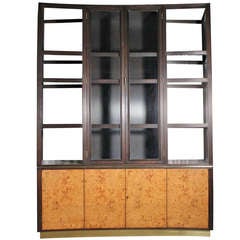Edward Wormley By Dunbar Kitchen Hutch
Recent Sales
Vintage 1950s Cabinets
Walnut
20th Century American Mid-Century Modern Cabinets
Vintage 1950s American Mid-Century Modern Cabinets
Nickel
Dunbar Furniture for sale on 1stDibs
Revered for its handcrafted and highly collectible mid-century modern sofas, coffee tables and other furnishings, Dunbar Furniture was founded in 1910 in Berne, Indiana, but it didn’t gain widespread recognition until the ’30s, following the introduction of its president to a designer who would leave an indelible mark on the company’s legacy: Edward Wormley.
After a stint at the Art Institute of Chicago, the Oswego, Illinois-born Wormley worked as an interior designer for Marshall Field’s before joining Dunbar in 1931. Initially focused on developing the company’s cheapest furniture line, which could be bought with soap coupons, he was soon leading Dunbar Furniture into a new era of residential furniture for modern American homes. He would serve as the company’s design director for over three decades, designing about 150 pieces each year.
During that time, he oversaw the production of designs in a wide range of materials, with influences ranging from Scandinavian modernism to Art Deco. There were modern upholstery pieces, like swiveling lounge chairs and low-slung sofas, and experiments with textural wood on bar carts and cabinets as well as minimal, sculptural tables and functional office furniture. A passionate collector of Tiffany Studios lamps, Wormley used their glass tiles in Dunbar tables in 1956. He also worked on the reproduction of pieces by designers such as Jean-Michel Frank and Richard Riemerschmid.
One standout Dunbar Furniture collection was Janus, introduced in the 1960s, with Austrian-born ceramicists Otto and Gertrud Natzler. These pieces see the Natzlers’ uniquely artful ceramic tiles set into several styles of wooden tables. They remain some of the most sought-after mid-century modern Dunbar pieces on the vintage market today. During the peak of his design career and, indeed, the height of Dunbar Furniture’s history, Wormley amassed a whopping 30 Good Design awards between 1950 and 1955 through the “Good Design” exhibition, hosted by the Chicago Merchandise Mart and the Museum of Modern Art. Dunbar today produces a limited selection of archival Wormley designs, but many sales of original Dunbar pieces are through the resale market.
Find a collection of authentic vintage Dunbar Furniture today on 1stDibs.
Finding the Right cabinets for You
Although traditionally used in the bedroom to store garments that would not be hung in a closet, an antique or vintage cabinet can easily find a purpose in rooms throughout your entire house.
The world's first storage cabinets, reportedly constructed in Renaissance-era Europe, were demonstrative of excellence in carpentry and the work of master carvers. These robust bureaus or sophisticated chests of drawers were typically built from common woods, such as oak or walnut. Although they were fairly uniform in structure and lacked the bright colors of modern-day furniture, case pieces and storage cabinets that date from the 18th century and earlier were often found in the homes of nobility.
Their intricate carvings and various embellishments — adornments made from ivory, ornate lacquer work and, later, glass shelvings — reflect the elegance with which these decorative furnishings were associated. Given its valuable purpose and the beauty of the early furnishings' designs, the storage cabinet is an investment that will never go out of style.
The practical design that defines the earliest storage cabinets has inspired the creation of household must-haves, like minimalist drink trolleys and marble wood bookcases. From hiding outdoor gear in the mudroom to decluttering your kitchen with a tall kitchen pantry cabinet, these versatile furnishings have now become available in enough sizes, styles and colors to accommodate any space. After all, these aren't your run-of-the-mill filing cabinets.
A sophisticated storage cabinet — wood storage cabinets with doors and shelves, for example — can serve as a room divider when necessary, while the right vintage wall unit or floor-to-ceiling cabinetry solutions can seamlessly become part of any space without disrupting the energy of the room. And although you may hide items away in its drawers, bookworms might prefer a storage cabinet with open shelving for displaying favorite books or other media.
One-of-a-kind solutions for the modern consumer abound, but enthusiasts of understated, classical beauty may turn to Baroque-style storage cabinets. Elsewhere, admirers of mid-century modernism looking to make a statement with their case pieces will warm to the dark woods and clean lines of vintage storage cabinets by Paul McCobb, Florence Knoll or Edward Wormley.
Sometimes the best renovation is a reorganization. If you're ready to organize and elevate your space, a luxury storage cabinet is the addition you need.
Find a variety of vintage and antique storage cabinets on 1stDibs, including unique Art Deco storage cabinets, chinoiserie cabinets and more.

